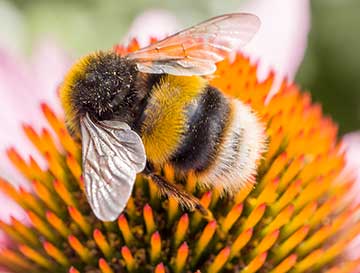 |
Previous Issues |
| Cedar Mill Community Website |
|
Search the Cedar Mill News: |
About The Cedar Mill News |
|
|||||||
| Volume 13, Issue 5 | May 2015 |
||||||
Bumblebees!
|
||||
 |
| Photo by James E. Petts, Creative Commons |
Bumblebees live in colonies with one queen who is the mother of every bee in the hive. In spring she wakens from hibernation and finds a suitable place for her nest, usually in the ground in abandoned rodent burrows, the foundations of buildings or stacks of firewood. She gathers nectar and pollen, storing it in the nest for her offspring. After laying eggs she warms them with her abdomen, leaving the nest only to feed. She cares for the first larvae and young bees herself until they can leave the hive and help to gather nectar for the next larval bees. Bumblebees do not make lots of honey like honeybees, but only enough to nourish the residents of their hive.
Their diet consists of diverse pollen and nectar sources. They are important pollinators in greenhouses where vegetable crops like tomatoes and peppers are grown. Berries, fruit trees, squash, and melons are also pollinated by bumblebees. Plant a few natives in your garden as these have the most nectar for the bees and other pollinators. A list can be seen on the website xerces.org.
During summer, new queens and male bees are hatched in the colony. After mating, the males die and the young queens leave the nest to forage alone until autumn when they will find a place in the ground to hibernate. The following spring they will emerge to begin the cycle all over again. Bumblebees only live for one year.
Bumblebees can sting but are generally not aggressive if left undisturbed. Because they are large and move slowly, I find it fun to observe their work in the garden. They love foxgloves, which can grow to about two feet tall. Children will enjoy watching them, too, and should be taught to look but don’t touch, as with all wild critters.
Remember that these creatures need a chemical-free garden in which to thrive… and so do we, our children grandchildren and pets!
Questions? Email me at margierose2@gmail.com or call 503-645-2994.
![]()
Like us on Facebook for timely updates
Published monthly by Pioneer Marketing & Design
Publisher/Editor:Virginia Bruce
info@cedarmillnews.com
PO Box 91061
Portland, Oregon 97291
© 2013